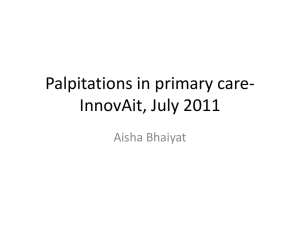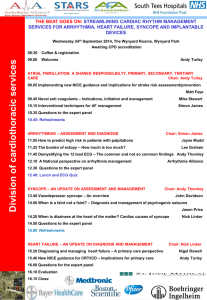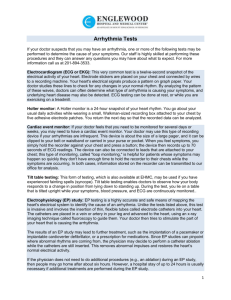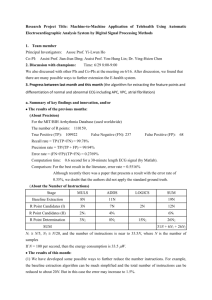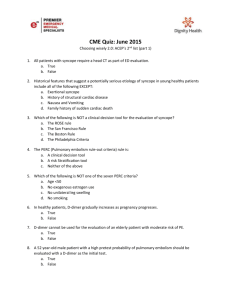Arrhythmia from a GP Perspective
advertisement
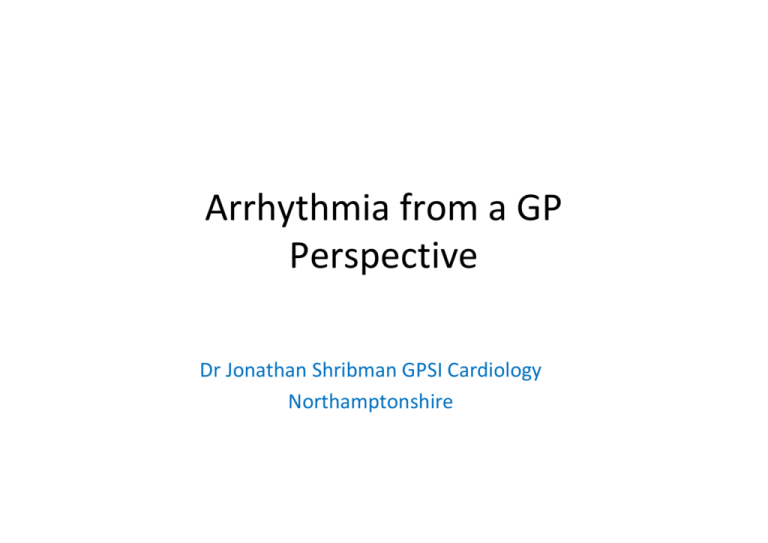
Arrhythmia from a GP Perspective Dr Jonathan Shribman GPSI Cardiology Northamptonshire Arrhythmia from a GP Perspective • • • • • • Common presentation in General Practice Associated with considerable morbidity But often benign cause Significant social impact Nevertheless potentially lethal Chapter 8 of NSF for CHD Arrhythmia from a Patient Perspective • “I know something's wrong (but nobody takes me seriously)” • “My heart keeps thumping (and I am really worried I am going to die)” Arrhythmia from a Patient Perspective Diagnoses: • “I know something's wrong but nobody takes me seriously” Diagnosis:fast paroxysmal SVT 180/min • “My heart keeps thumping and I am really worried I am going to die” Diagnosis:benign palpitations in young man with brother who died from MI Key elements of initial 10 minute consultation • Let the patient tell their story • Encourage patient to disclose their ideas concerns and expectations(I:”It’s my heart”, C: “its serious”, E: “I’ll loose my HGV licence”) • Ensure you have a construct or structure for thinking about the variety of presentations ‐ see charts to follow • Include FH of sudden death and comorbid conditions(Hypertension IHD Thyroid disease) • Focused examination: – Pulse rate and character – Sitting & standing BP • Presence or absence of heart murmur or heart failure • Appropriate investigation: see charts below Presentations • • • • • • Palpitations Dizziness Chest pain Breathlessness Syncope and pre‐syncope Complications eg CVA or embolic episode Palpitations • Oxford dictionary: a noticeably rapid,strong, or irregular heartbeat. • Less than 10% of patients will have a significant arrhythmia • Poor correlation between symptoms and arrhythmia • Significant arrhythmias are no more reliably reported When are palpitations likely to be an arrhythmia? High Positive predictive Value of : • Symptoms at work • Symptoms during exercise • Symptoms disturbing sleep • Regular palpitations RED FLAGS: High Pre test odds •Known Structural heart disease •On Cardiovascular drugs •Male •Increased age •Low anxiety(HAD) score Arrhythmia provoking (Arrhythmogenic) syncope ~ 15% of syncope might be caused by an arrhythmia • Palpitations are not common and pre‐syncopal symptoms often brief with Arrhythmogenic syncope • Often poorly investigated • Associated with an increased mortality • Risk stratification of syncope: various approaches: OESIL score: Eur Ht J 203 May 24(9):811‐9 – CVD in history – syncope without prodrome – abnormal ECG – age >65 Death within one year: 0 factors 0%, 1 factor 0.8%, 2 factors 19.6%, 3 factors34.7% and 4 factors 57.1% Diagnostic tests 12 lead ECG: • An abnormal ECG might point towards a diagnosis • A normal ECG makes a life threatening arrhythmia unlikely, but not impossible • Draw‐back: considerable experience required • Automatic reporting more useful as Rule Out but variability in ECG algorithms Ambulatory ECG monitoring: • Aims to correlate symptoms with detected ECG abnormality • Only useful if daily symptoms • Difficult to interpret • A variety of models for service delivery exist : – – – – Practice owns device as well as interpretive software Practice owns device but analysis takes place elsewhere Open access to ambulatory rhythm monitoring. Standard secondary care referral or GPSI Cardiology referral How to avoid mistakes • • • • • Select patients carefully Traffic lights system – red flags Correlate symptoms and rhythm 24 hr ambulatory ECGs give a low yield Put yourself in the shoes of the reporting physician Risk stratification Skipped beats Thumping beats Short fluttering Slow pounding AND • Normal ECG AND • No Family History AND • No Structural Heart Disease • • • • Low risk Manage in Primary Care • • • • History suggests recurrent tachyarrhythmia Palpitations with associated AND/OR symptoms Abnormal ECG AND/OR Structural heart disease Refer to cardiology Palpitations during exercise • Palpitations with syncope/near syncope • High risk of structural heart disease • Family history of inheritable heart disease/SADS • High degree AVblock • Refer to cardiology with urgency From PCCJ, Wolff and Cowan 2009 Management of Palpitations in Primary Care Guidelines p1 Patient with Palpitations Careful history and examination ; check pulse, BP ECG; FBC, U&E, TFT and BNP Consider Echo (murmurs, abnormal ECG or CXR) Consider chest pain clinic if anginal symptoms Sinus tachycardia or ectopic beats AF, chronic or paroxysmal Adverse features (see reverse) Paroxysmal SVT Adverse features (see reverse) See AF Guidelines Y Unknown Arrange ambulatory ECG (see reverse) N N Y Reassure. Advice on lifestyle, caffeine and alcohol Refer to Secondary Care (see over) Treat according to diagnosis, refer to Secondary Care if still uncertain Based on documents from Avon Gloucester and Wiltshire Cardiac Network Management of primary care guidelines p2 Diagnosis of arrhythmia from history • History is often more important than investigations. May be worth re-assessment after teaching patient to take pulse during attack (record rate and regularity) • Sinus tachycardia: anxiety, not clearly defined attacks, there all the time, have it now, pulse <110 during attacks • Ectopic beats: missed beats and thumps, go away when active, worst at rest, in bed • SVT: very clearly defined attacks, minutes or hours, can see the pulse or the heart beating, rate often >120 • Paroxysmal AF, may last up to days at a time, totally out of rhythm, often SOB, chest pain Adverse features of arrhythmia •Presence of structural heart disease (known CAD, cardiomyopathy, valve disease, abnormal rest ECG or CXR •History of chest pain, SOB when NOT having palpitation •Syncope (especially on exercise) •FH of sudden death (cardiomyopathy (always ask) •Intrusive symptoms which persist after initial treatment •All paroxysmal non-AF SVT unless very short and infrequent (can be cured with ablation in majority of cases) Ambulatory ECG monitoring in primary care •Careful history (see above) is more likely to yield arrhythmia diagnosis than investigations •24 hour tape only useful if symptoms frequent (there most of the time, most days) •Cardionetics C.Net 5000 now widely available in primary care and doesn't need Holter type technician review •Omron HCG 801 (£250) can be kept for 1 month and attached when an episode occurs, downloaded to PC and attached to GP record Syncope (Transient Loss of Consciousness ) p 1 N Do basic tests (see reverse) FEATURES OF VASOVAGAL SYNCOPE? (see reverse) Y Y TAKE CAREFUL HISTORY, FROM WITNESS IF POSS (see reverse) PREVIOUS EPISODES? Treat according to known diagnosis KNOWN DIAGNOSIS? N ADVERSE FEATURES (see reverse)? Y N N FEATURES OF CARDIAC ARRHYTHMIA (see reverse) IMPLANTED DEVICE (ICD/PACEMAKER? Y Y PRESENTING ACUTELY? N N FEATURES OF EPILEPTIC FIT; HISTORY OF BRAIN INJURY? (see reverse) Y Y Follow epilepsy guidelines; consider neurology referral N OTHER FEATURES eg anaemia, diabetes hyponatraemia, PE, TIA, intoxication, drug side effects, device malfunction etc? Reassure. Syncope Clinic if recurrent. Advise re salt and fluid intake, sensible diet etc Y ADMIT • Refer for Cardiology opinion; • order echo and • appropriate ambulatory monitoring Treat accordingly N POSSIBLE PSYCHOGENIC CAUSE? Multiple somatic symptoms, attacks occur “to order”, evidence of awareness during attack, etc N UNEXPLAINED SYNCOPE Y Reassure, consider psychiatric assessment Y Refer syncope clinic Based on documents from Avon Gloucester Wiltshire Cardiac Network Syncope (Transient loss of consciousness) guidelines 1 • • • • • FEATURES OF VASOVAGAL SYNCOPE: Posture: Usually on feet Prodrome: Nausea, heat, slow thumpy pulse, sounds distant, vision black, feeling faint, looks pale Precipitant: Standing, hot crowded noisy room, pain, other illness: restaurant, aircraft, micturition, cough, fear, emotion, instrumentation, venesection Often no injury in fall; often all tests (including tilt test) negative FEATURES OF CARDIAC ARRHYTHMIA: • Posture: any: standing, sitting or lying •Prodrome: none at all, sudden onset and recovery like a switch; rapid palpitation or chest pain •Immediate recovery on cessation •Precipitant: totally random •Often injury to face or head in the fall FEATURES OF EPILEPSY: • Prodrome: patient knows an attack is coming on; aura •Starts with head turn; absence of pallor •Body tone maintained during attack, automatic sounds, movements •Seizure, lateral tongue biting, incontinence (though can occur with other causes) • Post-ictal state – takes some hours for full recovery after cessation e.g. nausea headache confusion Syncope (Transient loss of consciousness) guidelines 2 BASIC EXAMINATION: •Pulse and BP (lying and standing) •Heart murmurs, evidence of heart failure •Peripheral pulses and bruits BASIC TESTS: •12 lead ECG •FBC, U&E and TSH and BNP if available •Consider CXR, echo (if suspicion of structural heart disease) AMBULATORY ECG MONITORING • • •24 hour tape is very unlikely to provide useful information unless attacks are almost daily 1 week Novacor (R Test) or Omron cardiac memo may be useful If attacks are infrequent, but suggestive of arrhythmia, refer for implantable loop recorder SYNCOPE CLINIC in secondary care: • • • • •Multidisciplinary; structured interview; access to ECG, CXR, blood tests, •Ambulatory ECG (including 6 week loop recorder) and implantable loop recorder Tilt test, erect carotid sinus massage Advice on physical manoeuvres for vasovagal syndrome Liaison with neurology, care of the elderly Access to counselling and ongoing patient support Omron HCG 801 Heart scan 12cms or 5” Omron HCG 801 Heart scan 24 hr Ambulatory ECG: a safe investigation for GPs? • What pause is abnormal at night on a 24hr ECG: a) b) c) d) • 1.8 secs 2.4 secs 2.9 secs 3.2 secs What would you see a run of VT lasting 4 beats in asymptomatic patient: a) b) c) d) Admit to hospital immediately Refer for investigation If 12 lead ECG normal ignore Start amiodarone immediately 24 hr Ambulatory ECG: a safe investigation for GPs? • What pause is abnormal at night on a 24hr ECG, in a patient not taking BB: a) b) c) d) • 1.8 secs NO 2.4 secs NO 2.9 secs NO 3.5 secs YES if invg performed for syncope/presyncope may need pacing What would you do if you see a run of VT lasting 4 beats in asymptomatic patient: a) Admit to hospital immediately NO b) Refer for investigation YES, if 12 lead ecg, echo & ex ecg normal = low risk c) If 12 lead ECG normal ignore NO d) Start amiodarone immediately NO So like any other test you should be trained in its use…. The role of General Practice in arrhythmia care • • • • • • • • Triage and assessment of initial presentation Opportunity for diagnostics Management of appropriate conditions eg AF Simple CBT based advice for benign palpiations Patient and carer support Occupational and driving advice Screening and case finding eg Atrial Fibrillation Prevention of sudden cardiac death Patient and carer support • • • • • • Assess psychological impact Consider social implications Provide written information Support groups Access supporting resources Care coordination with secondary or tertiary centres RCT of brief educational and psychological intervention in pts attending a cardiac clinic with palpitations Mayou, Sprigings, Birkhead & Price Psychol Med (2002) • • • • • • 80 consecutive diagnosed patients with an benign palpitations with associated stress or disability Randomised – Intervention group ‐ usual care + nurse delivered intervention based on cognitive behavioural principles lasting 1 hour – Control group – usual care only Principle outcome was difference in proportion of participants with good or excellent researcher‐rated activity levels at 3 months Results: – 78% of Intervention and 43% of control group good or excellent result grade – OR 0.21 (95%CI0.08‐0.57) – statistically clinically significant benefit for the intervention group with an NNT of 3 (95% CI 2‐7) – Most Intervention patients had returned to normal activities incl vigorous exercise, most in usual care avoided any activities or exertion with the fear of palpitation All but one overseas subsidiary outcomes also showed the difference in favour of the intervention group and several differences reached statistical conclusion Conclusion a brief nurse‐delivered psycho‐educational intervention was an effective treatment for benign palpitation Screening and preventative opportunities • Opportunistic case finding of AF : SAFE study Increased practice prevalence by 50% from 1.04 to 1.6% (but 2%possible) Screening versus routine practice in detection of atrial fibrillation in patients aged 65 or over: cluster randomised controlled (SAFE) trial. BMJ 2007; 335: 383 • Athletes: Italian law vs. AHA and ESC proposed guidance Corrado D, Basso C, Schiavon M, Thiene G. Screening for hypertrophic cardiomyopathy in young athletes. New Engl J Med 1998;339:364–36 Recommendations for competitive sports participation in athletes with cardiovascular disease Eur. Heart J., July 2005; 26: 1422 – 1445 ( proposed European Guideleine) Recommendations and Considerations Related to Preparticipation Screening for Cardiovascular Abnormalities in Competitive Athletes: 2007 Update Circulation 2007, 115: 1643‐1655(proposed US guideleine) • Family history HOCM DCM • Sudden cardiac death: FH (Ch8 NDF CHD) Flow diagram illustrating the proposed screening protocol for young competitive athletes HCM was responsible for only one sudden death in athletes (2%), whereas it accounted for 7.3% of sudden deaths in the general non‐athletic young population Corrado, D. et al. Eur Heart J 2005 26:516-524; doi:10.1093/eurheartj/ehi108 Copyright restrictions may apply. Conclusions • Primary care has a major role to play in the Recognition, Diagnosis & Management of Arrhythmias • Screening/ case finding and managing AF • Contributing to prevention SCD • Key elements are: – The importance of the history, the individual and their family – Appropriate investigations and referral • Good general practice can do a great deal to support these patients Questions

